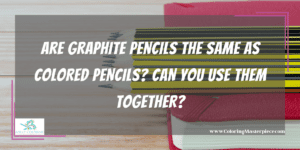Pencils are an excellent, inexpensive drawing and coloring tool available to you as an artist. They are easily found, come in a range of sizes and richness, and are easy to buy in bulk. Understanding the marks on the pencil is a little less clear for the uninitiated, though. What does the nomenclature mean? What does HB and 2B mean? Which one should you buy for your art project?
Most of us know what a pencil is—we’ve been using them for years, especially in school on standardized tests. Although most of us have been using and are familiar with the standard “Number Two” pencil, what does that mean? And what do the other odd nomenclatures mean that are written on the pencil body? Those short letters and numbers indicate how soft or hard the graphite core is, how black the graphite is, and how fine of a point it makes. But wait! Aren’t pencils made from lead? The following article will break all that down for you.
Here’s what you need to know about how (graphite) pencils are measured:

First, you might be surprised to find out that the “lead pencil” that we have all been using for years isn’t made from lead at all! Graphite and lead are two separate substances, and it’s graphite that you’ll find in your pencil. Although lead (a toxic metal) was commonly known and used for hundreds of years, when graphite (a crystal made from carbon) was initially discovered in England, the graphite was mistaken for lead and therefore named after lead. Furthermore, the name “lead pencil” stuck, even though it was technically made entirely out of something else. The transition to graphite is ideal, as graphite is far more lightfast than lead, meaning that UV light doesn’t break graphite down as quickly.
The “HB Scale” is a kind of grading system that manufacturers use to identify what kind of pencil you are getting. The nuance is relatively small, but you can tell the difference when comparing the pencil strokes to each other.
When you buy a pencil, you’re going to see one of two things: either a number all by itself or a letter and a number together. That’s because there are two different scales that pencil manufacturers use.
The NUMERICAL SCALE measures the hardness of the graphite core. These numbers range from 2 to 9, with “2” leaving a formidable mark on the paper and a “9” leaving a light mark. The lower numbers will dull quicker, meaning you have to sharpen them more frequently. If you buy a pencil that has a #2 on it, you’ll know that the pencil leaves a dark mark—this is why when most of us were growing up, we had to use a “Number Two” pencil for those scantron tests. The pencils gave off a heavy residue that scanning machines could easily read. This numerical scale was created initially to identify the difference in writing instruments and wasn’t intended to evaluate artistic instruments.
However, most pencil manufacturers use the HB GRAPHITE SCALE. This scale gives a much more comprehensive evaluation of what you can expect from the pencil than a mere number alone. To muck things up a bit, there are European and American graphite scales, and each manufacturer uses its measurements, so there’s quite a bit of wiggle room in this scale, and not all brands will be equal. That being said, here’s what you need to know about the HB Scale:
“H” indicates HARDNESS.
“B” indicates BLACKNESS.
“F” indicates how FINE A POINT the pencil has.
Okay, so let’s break that down:
H is for HARDNESS: When judging how hard a pencil is, it’s essential to know that the graphite powder is mixed with something called kaolin, which is a clay binder. Graphite on its own is too brittle and will break if it isn’t mixed with something. That’s where the kaolin comes in. Contrary to the way you might think about it, though, the more graphite powder that’s in the pencil, the softer the pencil is—soft as in it will crumble and leave a dark streak. The more kaolin that’s mixed in, the harder and more structured the pencil core will be.
Grading hardness is just a measure of evaluating the ratio of those two particles. The hardest pencil you can find contains about 20% graphite, and the softest one has about 90%. The 1:1 ratio corresponds to the 3H hardness. Left-hand users are going to want to use a pencil with an extra-hard core to prevent smudging. Be aware that harder pencil cores are going to be more difficult to erase from the page. If you are working on soft paper, the harder pencil core might puncture or crease your page unwantedly. Soft cores are going to give you a gentle, brush-like quality to the stroke.
B is for BLACKNESS: This is pretty self-explanatory. If you’re looking for a pencil that’s going to have a very dark mark on the page, you should look for a pencil that has a “B” rating. Furthermore, the more black the pencil, the higher the number you will want. 2B is only a little dark, while 7B is much darker. If you ever see “BB” or “BBB” on a pencil, it means that it’s black.
F is for FINE POINT: If you are doing a lot of sketching or drawings with very fine lines, you will probably want to look for a pencil with an F rating. “F” pencils are the only variety that doesn’t come with a number, as there is only one variant available. I presume that it’s because the F-rating is used less frequently than this is often called “The HB Scale”—bypassing the “F” entirely. Presumably, you could choose a pencil with an extra-hard lead that will also have a fine point if you couldn’t find an “F” pencil. The “F” pencil is rarely going to require sharpening.
Remember how I said that there were European and American scales? The American scale will combine the H-B-F and a number, which usually ranges from 1-4. This will tell you if it’s only a little hard or a little black, or if it’s hard or black. (Seriously. No puns intended.)
So where does a #2 pencil measure up?
Using the numeric scale, the #2 pencil is exactly as described. Using the HB scale, the #2 pencil’s equivalent is going to be “HB.” The pencil with an “HB” (hard black) core is the happy medium, combining maximum/ideal hardness and maximum/ideal blackness. Often pencil manufacturers will label their pencils HB #2 to cover both bases.
Are graphite pencils the same as colored pencils? Can you use them together?

The short answer is “no.” Colored pencils typically have a wax or oil-based core, with pigment added for the color. There is no graphite in colored pencils. It’s too bad we don’t have more words for “pencil” to differentiate between the two.
But can you use graphite pencils and colored pencils together in a drawing? Yes, you can, but you need to know a few things before you try this in your coloring book. Because colored pencils are comprised of wax or oil, the “ink” is reasonably resistant to smearing or erasing. Additionally, the “ink” will be resistant to adding pencil graphite on top of it. On the flip side, the graphite pencil is made by mixing graphite with a clay-based binder. Adding color to the top of standard pencil strokes will be much more comfortable than adding a pencil stroke to the top of a colored pencil coloring.
Simply Put: Use your graphite pencil first, then your colored pencil.
Additionally, you’ll want to consider using a pencil with a hard lead to prevent smearing on the page. If you don’t have a 7H pencil on hand, you might consider sealing the graphite before adding the colored pencil on top. Not only might the graphite smear, but the graphite is likely to mix in with the colored pencil pigment, making it a shade darker than you intend. To seal the graphite, you will spray a fixative to your drawing. Spray twice just for extra security.
This is a very informative blog with information about mixing graphite pencils and colored pencils, as well as a good tutorial on sealing your painting.
With this knowledge in mind, you’ll be able to purchase the right kind of graphite pencil for your artwork, and you’ll be empowered to combine the graphite and colored pencil to make a one-of-a-kind artwork that will wow your friends!
Interested in what colored pencils we recommend? Check out our list here!
Frequently Asked Questions
What kind of pencil should I use in my adult coloring books?
I would start with a typical #2 pencil (or HB or HB #2 pencil equivalents.) If you want to try some variations, try adding a 6B and a 6H pencil to the mix to see how they compare to the middle-of-the-road #2 pencil. The 6B will have a bolder, darker line and also be a little easier to smudge. The 6H pencil will make a light, fine line.
Do you have some weird pencil trivia?
I love trivia! Here are some fun ones. The original graphite sticks were wrapped in string or sheepskin for stability and to keep the graphite from staining the fingers. Today, there’s a Cumberland Pencil Museum in England near the original graphite mine site that tells the history of the factory and pencil-making. Here’s another lesser-known fact: H-B-F delineations weren’t named after “hardness-blackness-fine point” at all, initially. The Hardtmuth pencil factory named the HB pencil for Hardtmuth and Budejovice, and the F was named for Franz Hardtmuth. The European scale took those shortcuts and adopted them in their overall scale. One last bit of trivia! Before the graphite pencil came along, a pencil was made of lead called a “stylus.” The ancient Romans used this writing tool because it allowed them to write without ink.
Furthermore, the stylus could be sharpened to a very fine point and used to write (or carve) on wax tablets. The wax tablets were reusable because they could be melted down until smooth to start over. For more exciting pencil trivia facts, check out Today I Found Out.
What other types of pencils are there?
In addition to graphite pencils and colored pencils discussed in this blog article, there are other types of pencils. Charcoal pencils are made from a different form of carbon than graphite. They have the equivalent of an 8B graphite pencil. There are aquarelle or watercolor pencils, which give the impression of being like watercolor paints. There are also cosmetic pencils used for makeup and intended for drawing on the human face. Finally, there are pastel pencils, which are more like chalky bricks.
Looking for even more tips?! Click here to download my free adult coloring eBook and sign up for my email newsletter!
Disclaimer: The information provided by ColoringMasterpiece.com (“The Site”) is for general informational purposes only. All information on the Site is provided in good faith, however, we make no representation or warranty of any kind, express or implied, regarding the accuracy, adequacy, validity, reliability, availability, or completeness of any information on the Site. Under no circumstance shall we have any liability to you for any loss or damage of any kind incurred as a result of the use of the Site or Reliance on any information provided on the Site. Your use of the Site and your reliance on any information on the Site is solely at your own risk. This blog post is for educational purposes only and does not constitute legal advice. Please consult a legal expert to address your specific needs.
Terms and Conditions: https://coloringmasterpiece.com/terms-and-conditions/
